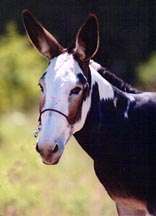Mule
N/A
Sat, 12th July, 2025 - 5:58 am GMT
Sponsor Ads:

Alternative Name
N/ABasic Info
The Mule is a cross between a donkey stallion (called a jack) and a horse mare. Hinnies are just the opposite - a stallion horse crossed to a donkey jennet. For all purposes, hinnies and mules are classified and shown together under the general term Mule. Mules ears are usually somewhat smaller than a donkeys, longer but the same shape as the horse parents. The mule’s conformation will be a combination of traits from both parents. The head, hip and legs usually take after the jack. Mules do not have pronounced arches to the neck, even from breeds such as Arabians or Warmbloods. A slight arch or straight neck is preferable to a ewe, or upward curved neck. The mule will have "combination hair," usually a thin forelock, coarse mane hair, and a tail more like the horse parent. Both mules and donkeys are shown with a variety of hairstyles from clipped to shaved (roached). Mules may wear their tails "belled" as decoration, left long and full, or clipped at the top to emphasize the shape of the hip. Voice Mules try their best to imitate the donkey’s bray, but most have a unique sound that is a combination of the horse’s whinny and the grunting of the wind-down of a bray. Most will start out - Whinee-aw ah aw. Color Mules usually have brown or tan-colored points, where in the donkey the Light Points are a shade of off-white. Some donkeys and mules do not exhibit any light points at all - this is not rare, but is a good identification marker for registration purposes. Old-timers used to call a dark muzzled mule "blue nosed." Mules can be any of the colors that either horses or donkeys come in, along with some unique variations of their own. The only colors mules do not come in is true horse pinto (due to the genetic factoring of these colors). Mules from Appaloosa mares often have extremely loud patterns, with spots enlarging or "skewing" in variants of the horse appaloosa. Breeders wishing for a mule with four white feet should try a tobiano mare. The mule will probably have four socks and/or stockings, with the most usual combination being four white feet and a splash of white on the tail. The genes of the mule seem programmed for the unusual, and very strange, loud spotted pinto and appaloosa variants are common. In fact, the best way to produce a spotted mule is to cross a spotted jack to a solid colored mare. The resulting mule may have pinto-like patched in a variation of the donkey-spot pattern. Appaloosa mares crossed to spotted jacks have often produced mule foals that appear to be roan-patched pinto, with dark leopard appaloosa spots over the dark areas. Size Mules come in every size and shape imaginable. Miniature mules (even to under 36") can be seen all the way up to 17 hand Percheron draft (by Mammoth Jacks) Mules. The Poitou donkey was used exclusively for breeding huge draft mules from a breed of draft horse called the Mullasier - the Mule producer. The build of the mule is a combination of both parents. The head resembles both, the eyes being more almond-shaped (inherited from the D-shaped eye socket of the donkey). Male mules may have more prominent brow ridges like those of most donkey jacks. The neck is straight and has little arch, even in mules from Arab or Warmblood mares. The overall body shape will be dependent on the conformation of both parents. Due to hybrid vigor, the mule has the possibility of growing taller than either parent. The rarer Hinnies are often said to be more horselike than the mule, but more often it is impossible to tell them apart. Hinnies may tend to be slightly smaller, simply because of the fact that most donkeys are smaller than horses.
Health
Terminology Mule: The hybrid animal produced when a male ass (Jack) is crossed with a female horse. The mule is a sterile hybrid, meaning it cannot reproduce. Mules come in both male and female. A tiny percentage of female mules have had foals, but this is considered a freak genetic accident. Mules are a combination of traits of the parents with the most obvious donkey traits being long ears, narrower body and smaller hooves. The horse contributes size, speed and muscle. Other characteristics such as the head and voice (an odd combination of the bray that ends as a whinny) are a blend of the parent features. You can always tell a donkey from a mule by the fact that a donkey has a tail in essence like a lion or a cow (long tail with a tassel) and the mule has a tail like a horse (short tailbone with long hair). Hinny: This is the term used for the hybrid animal produced when the female ass (jennet) is mated to the male horse (stallion) to produce a foal. There are both male hinnies and females. The genetic inheritance of the hinny is exactly the same as the mule. Scientists think that differences in hinnies and mules may be from the result of maternal influences on the fetus, and in the upbringing of the foal. Some hinnies tend to look like horses with long ears, but most cannot be told apart from mules. Untraced animals can not be verified as hinnies. For all purposes, hinnies are classified with mules. Hinnies do not differ from mules in endurance, or other useful traits, but are bred more rarely because the donkey dam tends to make the offspring smaller. Donkeys do not as readily conceive to horse stallion as to donkeys. The equine hybrid is easier to obtain when the lower chromosome count (the donkey) is in the male. Horse Mule: The proper term for the male mule. All male mules should be gelded, since stallion mules are very sexually active, even though they are sterile. Many people refer to a male mule as a john mule, but the term is informal. Mare Mule: The proper term for the female mule. The common informal term for the female mule is molly mule, and is frequently used. Mare Hinny or Horse Hinny: The terminology for the hinny follows that of the mule for clarity. Mule Colt or Mule Filly: The young male or female mule under the age of three. When show classes are listed they are frequently listed as "Mare Mule under One year of age" etc. This is of course correct but more difficult to use in speech. Miniature Mule: Bred from various types of pony mares or Miniature Horse mares. 50" at the withers is considered the cut-off height for miniature mules. Saddle Mule: Bred from mares of riding horse breeding. These vary in size from small to very large but having riding type confirmation. Pack/Work Mules: Bred from mares with some draft blood or of heavy work types rather than for saddle type confirmation. Draft Mules: These are the largest mules and are bred from various Draft mares. Belgian mules are the most common, valued for their bright sorrel color, but mules from Percheron, Clydesdale, Shire and other draft breeds are also seen. The larger and heavier the better with these mules, but refinement is desired as well. Gaited Mules: Bred from the saddle-gaited horses including Tennessee Walking, Foxtrotter, Paso Fino and Peruvian Paso. A jack exhibiting a smooth singlefoot type gait is desirable as the sire of these mules. Gaited mules have their own registry in the American Gaited Mule Association, which requires qualification testing of the animal to show gait, as well as video evaluation of the sire and dam. These mules may also be registered in the American Mule Registry (ADMS) as Saddle Mules of gaited breeding.Habitat
N/ABehavior
In Medieval Europe, when horses were bred large to carry armored knights, mules were the preferred riding animal of gentlemen and clergy. In 1495, Christopher Columbus brought four jacks and two jennies to the New World. They would produce mules for the conquistadores' expeditions onto the American mainland. Ten years after the conquest of the Aztecs, the first shipment of twelve jennies and three jacks arrived from Cuba to begin breeding mules in Mexico. Female mules were preferred as riding animals, whereas the males were used as pack animals along the trails that tied the Spanish Empire together. Both mules and hinnies were used in the silver mines. Along the frontier each Spanish outpost had to breed its own supply of mules, and each hacienda or mission maintained as least one stud jack. Mules were once used to pull fire-fighting equipment and were often employed by armies to pull artillery and to remove the wounded from the battlefield. The twenty-mule team that hauled borax from Death Valley and other mining centers in the West has become part of American legend. Indeed, some western towns were originally laid out with extremely wide streets to allow the mule teams to turn around. The main mule-breeding centers in the United States developed in Tennessee, Kentucky and Missouri to provide work animals for the cotton fields of the Old South. After the American Civil War and the development of tenant farming throughout the South, the mule continued as the major draft animal in American agriculture. "Forty acres and a mule" was all one needed for self-sufficiency. The importance of the mule declined rapidly in the 1940s and 1950s, however, as gasoline-driven tractors became widespread, and mules all but disappeared from the American scene. Today there is renewed interest in mules for recreation and competition. In the Southeast mules are used for nighttime raccoon hunting, and the mules' ability to jump over fallen trees or fences is exploited in jumping competitions. Pulling contests using heavy draft mules have created a new demand for large mules. Particularly popular are large red mules produced by crossing American Mammoth Jackstock with Belgian mares.Origin
EuropeHistory
Under conditions of domestication it is possible to obtain hybrids between equid species. There are records of onager/ass, onager/horse and zebra/horse (zebroids) crosses, but the cross that has been most significant in human history is one between horses and donkeys. Breeding a male donkey to a female horse results in a mule; breeding a male horse to a female donkey produces a hinny. Offspring from either cross, although fully developed as males or females, are almost always sterile. Hence, a line of horses and a line of domestic asses must be maintained to perpetuate mule or hinny production. The mule in most circumstances has been the preferred product of the horse/ass cross. (The breeding is also easier to manage.) The mule has greater endurance and is stronger and less excitable than a horse. Depending on the need, different breeds of horses can be used to produce fine riding mules, heavy draft mules or medium-sized pack animals. In Medieval Europe, when horses were bred large to carry armored knights, mules were the preferred riding animal of gentlemen and clergy. In 1495, Christopher Columbus brought four jacks and two jennies to the New World. They would produce mules for the conquistadores' expeditions onto the American mainland. Ten years after the conquest of the Aztecs, the first shipment of twelve jennies and three jacks arrived from Cuba to begin breeding mules in Mexico. Female mules were preferred as riding animals, whereas the males were used as pack animals along the trails that tied the Spanish Empire together. Both mules and hinnies were used in the silver mines. Along the frontier each Spanish outpost had to breed its own supply of mules, and each hacienda or mission maintained as least one stud jack. On the Iberian Peninsula, Catalonia and Andalucia each developed a large breed of ass, putting Spain in the forefront of the mule-breeding industry. Exportation of Spanish jacks was prohibited until 1813. However, the King of Spain presented George Washington with a large black jack in 1785. This animal, "Royal Gift," is considered the father of the mule industry in the United States. Mules were once used to pull fire-fighting equipment and were often employed by armies to pull artillery and to remove the wounded from the battlefield. The twenty-mule team that hauled borax from Death Valley and other mining centers in the West has become part of American legend. Indeed, some western towns were originally laid out with extremely wide streets to allow the mule teams to turn around. The main mule-breeding centers in the United States developed in Tennessee, Kentucky and Missouri to provide work animals for the cotton fields of the Old South. After the American Civil War and the development of tenant farming throughout the South, the mule continued as the major draft animal in American agriculture. "Forty acres and a mule" was all one needed for self-sufficiency. The importance of the mule declined rapidly in the 1940s and 1950s, however, as gasoline-driven tractors became widespread, and mules all but disappeared from the American scene. Today there is renewed interest in mules for recreation and competition. In the Southeast mules are used for nighttime raccoon hunting, and the mules' ability to jump over fallen trees or fences is exploited in jumping competitions. Pulling contests using heavy draft mules have created a new demand for large mules. Particularly popular are large red mules produced by crossing American Mammoth Jackstock with Belgian mares.Common Foods
grassSponsor Ads:
Money is how people with no talent keep score. -- Michael Hart, Brief History of the Internet, 1995
Mule
Coded by: BGID® | ALL RIGHTS RESERVED Copyright © 2000-2025
Disclaimer | Privacy | Report Errors / Contact | Credits








 President of the United States of America - Real Estate mogul, Pageant owner and now one of the most controversial men in political history.
President of the United States of America - Real Estate mogul, Pageant owner and now one of the most controversial men in political history.  Global warming has been in and out as the "latest" hot topic for many years. It is, according to modern scientists, the result of man-made industrial pollutants, clearing forested areas, agriculture, etc. But now they are thinking it started way before the Industrial Revolution...
Global warming has been in and out as the "latest" hot topic for many years. It is, according to modern scientists, the result of man-made industrial pollutants, clearing forested areas, agriculture, etc. But now they are thinking it started way before the Industrial Revolution...  Politician, US Vice President and President of the USA - Joseph Robinette Biden Jr.
Politician, US Vice President and President of the USA - Joseph Robinette Biden Jr.  versus
versus  Russia: 'The Evil Empire'? Are they all that bad or is it just the USA trying to portray Russia as bad because they are a world power with land bigger and a society very different from the USA ideal?
Russia: 'The Evil Empire'? Are they all that bad or is it just the USA trying to portray Russia as bad because they are a world power with land bigger and a society very different from the USA ideal? 
 Corona virus
Corona virus 
 Users with wide screen monitors can benefit from more content on every page.
Users with wide screen monitors can benefit from more content on every page.